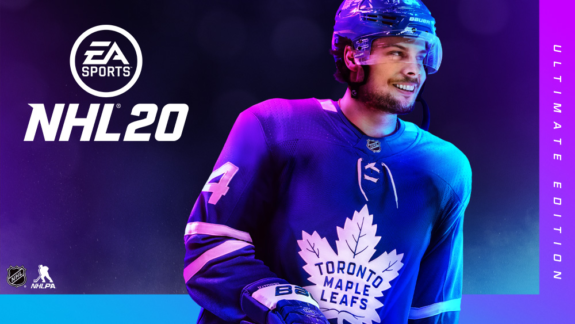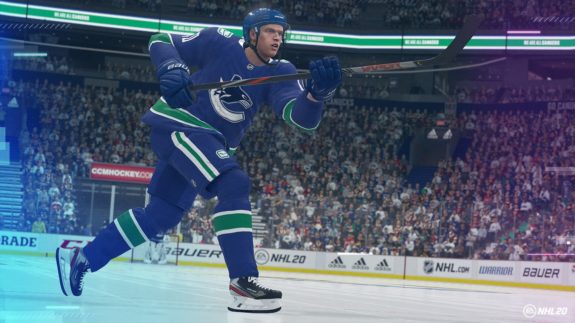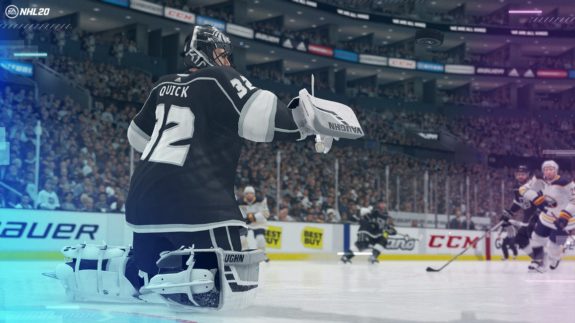NHL 20 is going to feel better and faster than NHL 19 and any other previous iteration of the famous gaming franchise.
It may seem hard to believe given how familiar and almost recycled sports games have come to feel year in and year out, but NHL 20 took all of the positives that NHL 19 brought to the table and have ramped them up to be a significantly improved game from the year prior.
For anybody who played the NHL 20 open beta, there’s reason to remain skeptical on how improved this year’s game can truly be. This is especially true given the beta played very much like NHL 19 and that had glaring issues such as the puck’s continued exit from the ice surface and over the glass to even the sluggish speed of passes.

What many people don’t realize, however, is that the version of the game being released on Sept. 5 for early access is a much more polished version of the game than what the beta presented.
When speaking with William Ho, the creative director for NHL 20, this and the drastic changes to the game, in general, were discussed.
“The beta came out in late July. The way we work with Sony and Microsoft is that we actually have to freeze that beta in early June and it gets released several weeks later,” Ho said. “Within those several weeks, we actually continue polishing the game and there were literally hundreds of improvements during that window.”
Having played previous iterations of the NHL franchise (including NHL 19) the NHL 20 beta and the version of the game that will be released on the Day One patch, there was a stark difference in the way the game felt.
There were a few “janky animations,” as Ho would describe them, that were very glaring and have certainly been addressed since the beta.
Below is the official NHL 20 Gameplay Trailer
Ho would also go into great detail about three key ideas that had to do with improved gameplay in NHL 20.
The first key idea Ho mentioned was improved shooting using Real Player Motion (RPM) tech which has only gotten better since last year.
“Basically in every different situation in the game, every scoring opportunity, every distance to the net, every angle [the player is] facing, every angle the puck is incoming, every skater in the game is improved dramatically because we don’t have just two shots to choose from, we have literally hundreds of different shot animations depending on the context and the skater will pick the best shot depending on that context.”

Outside of just the improvements made to shooting and the contextual cues used by the skater AI, there are also roughly 20 players in NHL 20 (coincidentally or not) that feature signature shots. Players like P.K. Subban, Auston Matthews, Brent Burns, Alexander Ovechkin and others now have shots in NHL 20 that accurately reflect their real-life counterparts.
“With all of these guys, we had our animators look frame by frame as reference to make sure they’re accurate to the real-life shots,” Ho would explain. “For instance, with Laine, he really gets underneath the puck to get full power on his shot, so we feel that if your favorite player is one of [the players that have a signature shot], you’re going to recognize their moves.”
The second key idea that Ho mentioned related to how all of these actions that are done in motion can be done in full speed.
Related: NHL 20: Improvements From the Beta
Elaborating on the topic, Ho mentioned that things like shots, puck pick-ups and the like would often cause skaters to lose speed in NHL 19 due to the limited animations in the game at the time.
With all of these new animations that allow players to reach in any direction to make a pass or receive a pass, the game not only feels smoother and more fluid (much like hockey is actually meant to be played) but it also feels faster as a result.
The third key idea that Ho mentioned (which should make many fans of the NHL franchise happy) is that goaltending will be much improved in NHL 20.
Goaltenders are now smarter and have more tools at their disposal which should make them feel far more realistic than the versions we’ve seen in previous years. There are new glove saves, kick saves and freezes (such as a chest cover and covering on the ice) as well as deliberate redirects into the corner towards a teammate and away from an opposing forward.
In the past, many have complained about goaltenders and the way their interactions have often led to free goals in the past. While this can be annoying in a regular game, it was even more annoying for those playing in EASHL clubs with their friends and being forced to watch helplessly as their goaltender gave up an easy rebound to a trailing forward who could knock in the easy goal.

In general, the NHL 20 experience should be an improved one to that of NHL 19. While it may seem like a lot of these changes are subtle, there was a lot of work that went into truly polishing what an authentic hockey experience is meant to feel like.
There will undoubtedly be kinks to work out along the way, but the team at EA did an excellent job at listening to their community, addressing their past shortcomings and improving the speed of the game not by changing any sliders, but by simply making it feel smoother and more fluid.